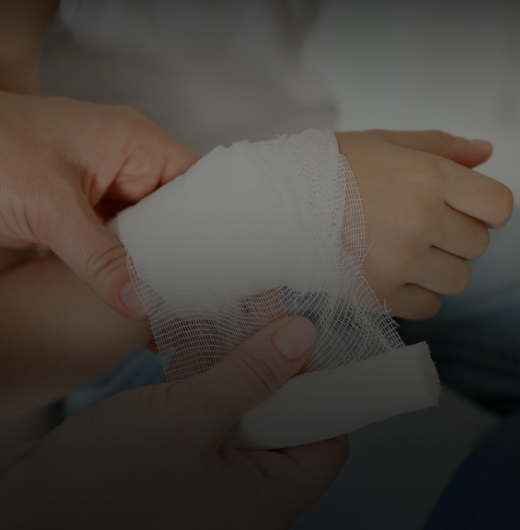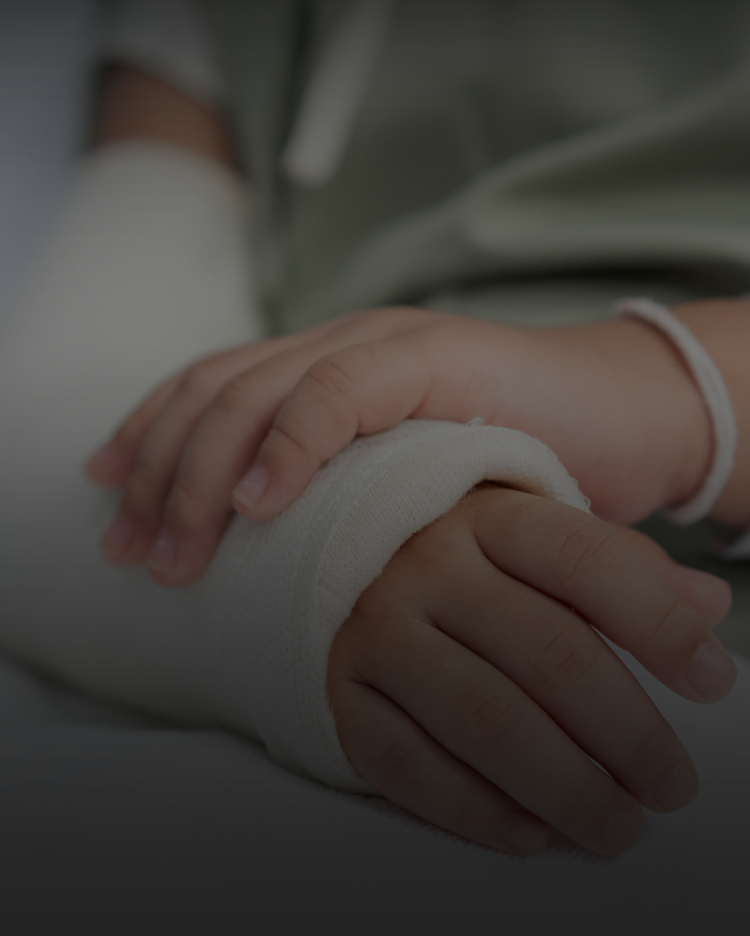If your child is injured in a car accident, seek immediate medical care. Document the incident, gather evidence, and contact an Ontario child injury lawyer for legal guidance and support.
The most common Ontario Child Injury Lawyer claims include accidents involving vehicles, falls, animal bites, and other serious injuries.
8 Common Child Injury Claims
As Hamilton child injury lawyers, we’ve seen firsthand the devastating impact that serious accidents can have on children and their families. Every year, countless kids in our community and across Ontario, suffer life-altering injuries due to accidents or someone else’s negligence. Whether the incident happens on the road, at home, at school, or in a public space, children are particularly vulnerable to injuries that can affect their physical development, emotional well-being, and long-term cognitive function.
Over the years, certain types of injuries have emerged as the most common in the cases we handle. Based on our experience, these are the eight most frequent child injury claims we see in our practice.


1. Car Accidents
Car accidents are one of the leading causes of child injuries in Ontario, whether as pedestrians, passengers, or in other scenarios involving negligent drivers. These accidents can result in serious injury, including traumatic brain injuries (TBI) and spinal cord injuries, both of which can alter the course of a child’s life forever.
Common Injuries from Serious Car Accidents
- Traumatic brain injuries (TBI): Head trauma is one of the most common and life-altering injuries children experience in car accidents, affecting their cognitive ability and development.
- Spinal cord injuries: These injuries can lead to permanent disability and require long-term medical treatment and disability support.
- Fractures: Broken bones, especially in younger children, can lead to complications that require surgery and months of rehabilitation.
When a serious accident occurs, families need a lawyer who understands the complexities of these cases and can pursue the compensation needed for medical bills, rehabilitation, and emotional recovery. Ontario trial lawyers association members specialize in handling these types of child injury cases.
2. Dog Bites and Animal Attacks
Dog bites and attacks are common causes of injury among children. While most pets are well-behaved, children can sometimes provoke an animal unintentionally, leading to bites or worse. These injuries can cause both physical pain and emotional trauma, often leaving lasting psychological scars on the child.
If your child is injured due to a dog bite,we can help you navigate the legal process and ensure that the responsible parties are held accountable. Hiring the right Hamilton dog bite lawyer can help you understand how to get compensation for long-term care, emotional harm, and more.
3. Pedestrian Accidents
Pedestrian accidents are a significant risk for children, especially in urban areas or near schools. When a child is hit by a vehicle, the resulting injuries can be severe and life-altering. In many cases, these injuries can include traumatic brain injuries, spinal injuries, or broken bones.
Common Injuries in Pedestrian Accidents
- Head injuries: A traumatic brain injury (TBI) is a common injury in pedestrian accidents, even from seemingly minor impacts.
- Fractures: Broken bones from a pedestrian accident require medical care and may lead to long-term physical limitations.
- Internal injuries: Serious accidents can lead to internal damage, which requires urgent medical treatment and ongoing care.
In cases like these, legal representation is crucial. A personal injury lawyer can help ensure your child’s rights are protected and that they receive the accident benefits and medical care they need.
4. Improper Use of Car Seats
Improper use of car seats or failure to properly restrain children remains one of the leading causes of serious injury in motor vehicle accidents involving young passengers. Even the safest car seat cannot protect a child if it is installed incorrectly, used inconsistently, or chosen without regard for the child’s age, weight, or height.
When parents or caregivers fail to follow proper safety guidelines—such as securing the harness tightly, positioning the seat at the correct angle, or transitioning a child too early to a booster seat—the risk of catastrophic injuries, including brain trauma or spinal cord damage, increases dramatically.
In the aftermath of a collision, improper restraint can be the difference between minor injuries and life-altering consequences. It is essential that parents understand and follow proper car seat safety protocols to protect their children on the road.
Also, using an old or second-hand car seat can be dangerous, especially if the seat is past its expiration date, has been in a prior accident, or is missing key safety labels or components. Without knowing the seat’s full history or whether it meets current safety standards, parents risk putting their child in a seat that may not provide adequate protection in a crash.
5. Bicycle Accidents Involving Children
Bicycling is a favourite activity for many children across Ontario, but it also comes with significant risks—especially when motorists fail to drive cautiously near young cyclists. Children are particularly vulnerable to severe injuries in bicycle accidents due to their smaller size, limited experience, and lack of protective infrastructure in many neighbourhoods.
Common Injuries from Bicycle Accidents
-
Head injuries: Even with helmets, children can suffer concussions or traumatic brain injuries when struck by a vehicle or thrown from their bike.
-
Fractures and orthopedic injuries: Broken bones, especially wrists, arms, and legs, are frequent and often require surgery or long-term rehabilitation.
-
Soft tissue and facial injuries: Cuts, abrasions, and dental trauma are also common, particularly if a child is not wearing adequate safety gear.
Bicycle accident claims involving children can be legally complex, particularly when fault or roadway design is at issue. An Ontario child injury lawyer can help identify responsible parties—whether a negligent driver, a municipality, or another third party—and pursue the compensation needed for recovery and future care costs.
6. Serious Traumatic Brain Injuries (TBI)
Traumatic brain injuries are among the most severe injuries a child can sustain. Whether caused by a car accident, a fall, or a blow to the head, TBIs can disrupt a child’s cognitive ability, causing long-term consequences in their ability to learn, interact, and live a normal life.
Children who suffer traumatic brain injuries (TBI) often face lifelong challenges that impact every aspect of their development and future. A TBI can interfere with a child’s ability to learn, communicate, and regulate emotions, sometimes causing permanent cognitive and behavioural impairments.
As the child grows, the effects of the injury can evolve—learning difficulties may emerge or intensify, emotional regulation may worsen during adolescence, and independence in adulthood may be significantly limited. These outcomes can deeply affect a child’s education, relationships, and long-term quality of life.
The costs associated with a pediatric brain injury are substantial and enduring. Families may face a lifetime of expenses related to specialized medical care, rehabilitation therapy, assistive technologies, educational supports, and, in many cases, long-term attendant care. Parents often become full-time caregivers or must navigate a complex system of public and private supports to ensure their child receives adequate treatment and assistance. The emotional and financial strain can be overwhelming, particularly when the injury was caused by another party’s negligence.
7. Falls and Playground Injuries
Falls are a leading cause of injuries among children, particularly on playgrounds or while playing at home. In some cases, unsafe playground equipment or poorly maintained facilities can lead to severe injuries.
Common Injuries from Falls
- Fractures and dislocations: Broken bones from a fall often require surgery and extensive rehabilitation.
- Concussions: Head trauma from falls can lead to concussions, affecting a child’s mental and physical abilities.
If your child is injured in a fall, you may be entitled to compensation if negligence was involved. Child injury casesinvolving faulty equipment or unsafe conditions can be complex, and having an Ontario child injury law firm on your side ensures the right steps are taken to protect your child’s future.
8. Burns and Scalds
Children are particularly at risk for burns and scalds, often from hot water, stoves, or other household appliances. These injuries can be devastating, requiring ongoing medical treatment and rehabilitation.
Types of Burns and Their Impact on Children
- First-degree burns: These affect the skin’s surface and typically heal with minimal intervention.
- Second- and third-degree burns: These more severe burns can cause deep tissue damage and long-term scarring.
In burn cases, legal representation ensures that your child gets the medical care and compensation they deserve. An experienced child injury lawyer can help families get compensation for long-term care needs and emotional trauma.
Lalande Personal Injury Lawyers definitely deserve their 5 stars. Many thanks to Matt and Heather, who took over our wrongful death claim after we discovered our original lawyer had done almost nothing on our claim in nearly two years. Due to their diligent efforts, our claim has now been concluded successfully and satisfactorily. We regret now that we had not considered the reviews of former clients when first choosing our original lawyer. It would have saved us so much stress and time if we had believed the reviews and just made Lalande Personal Injury Lawyers our first choice. – Annette
Trusted Ontario Child Injury Lawyer for Child Injury Claims
When your child is injured due to negligence, having a personal injury lawyer on your side is crucial. At Lalande Personal Injury Lawyers, we understand the emotional and financial strain these situations cause. Our Hamilton child injury lawyers offer free consultations to guide you through the legal process and ensure your child receives the compensation they deserve. Contact us today at 905-333-8888 or by sending a confidential email for a free case evaluation today.
Article FAQ
An Ontario child injury lawyer can help hold the dog owner accountable, ensuring your child receives compensation for medical expenses, pain and suffering, and emotional trauma caused by the bite.
The process involves filing a personal injury claim, gathering medical evidence, negotiating with insurance companies, and possibly going to court. A child injury lawyer will guide you through every step.
Yes, emotional trauma is considered in child injury claims. A skilled Ontario child injury lawyer will ensure that both physical and emotional damage is taken into account when seeking compensation.
The timeline for resolving a child injury claim varies based on the complexity of the case. A Hamilton child injury lawyer can provide an estimated timeframe based on your child’s specific injuries and circumstances.


